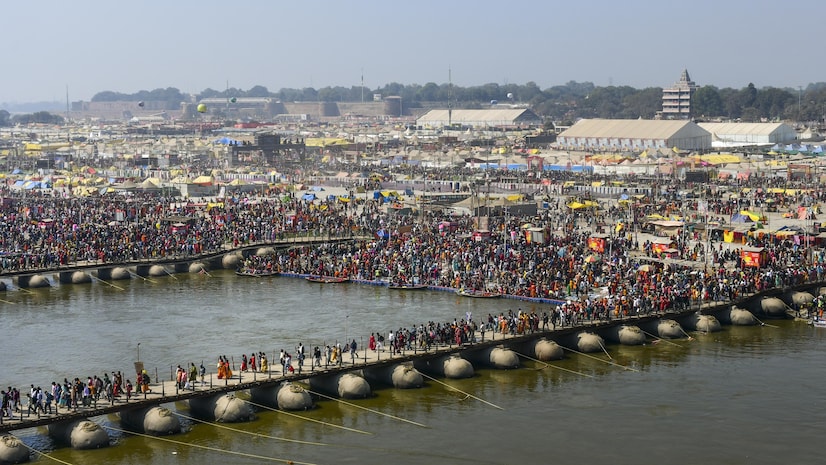Sociological Perspectives on Mahakumbh: Unity, Ritual, and Social Transformation
Introduction
The Mahakumbh, as the world’s largest religious gathering, serves as a microcosm of Indian society, offering rich terrain for sociological analysis through functionalist, conflict, interpretative, and Indological frameworks.Hierarchical Analysis of Key Sociological Perspectives
### 1. Structural Functionalism (Émile Durkheim, Talcott Parsons, Robert K. Merton)
Durkheim’s collective effervescence explains the Mahakumbh’s unifying power, where ritual participation reinforces social solidarity[3][7]. The event acts as a social fact, transcending individualism to reaffirm Hindu identity. Merton’s latent functions are evident in its economic impact (small businesses earning ₹200 crore)[4] and manifest functions in spiritual renewal. Parsons’ pattern variables apply to the temporary suspension of caste hierarchies during the holy dip, fostering universalism over particularism[1][2].
*Durkheim*:
> *“The sacredness of the ritual creates a moral community... collective sentiments are revitalized.”*
### 2. Indology (G.S. Ghurye)
Ghurye’s emphasis on textual traditions aligns with the Mahakumbh’s mythological roots in the *Samudra Manthan*[6][7]. The festival’s cyclical recurrence every 12 years reflects the Hindu conception of time as both linear and cyclical, reinforcing *sanatana dharma*’s continuity[7].
*Ghurye*:
> *“Indian festivals are the living embodiment of *shastraic* injunctions.”*
### 3. Sanskritization (M.N. Srinivas)
The participation of Dalits, *Kabirpanthis*, and transgender *akharas*[4] demonstrates sanskritization—lower castes adopting ascetic practices to elevate social status. However, Srinivas noted this process’s limits in dismantling structural inequality, as *naga sadhus* retain hierarchical privileges[6].
*Srinivas*:
> *“Sanskritization bridges but never dissolves caste.”*
### 4. Interpretative Sociology (Max Weber)
Weber’s verstehen method decodes the *kalpavasis*’ subjective meanings: ritual bathing as *prāyaścitta* (atonement)[3] and the *akhara* system as *zweckrational* (goal-oriented asceticism)[6]. The *sanyasi*’s renunciation exemplifies other-worldly mysticism, contrasting with Protestant inner-worldly asceticism.
### 5. Marxist Perspective (A.R. Desai)
Desai’s dialectical materialism critiques the Mahakumbh as a site of commodification, where spiritual capital is exploited by political elites (e.g., BJP’s “development” narratives)[4]. Yet, the *langars* (community kitchens) signify primitive communist ideals of resource-sharing[2].
*Desai*:
> *“Religion is the sigh of the oppressed creature... yet here, it momentarily suspends alienation.”*
### 6. Feminist Sociology
The inclusion of women *mahamandaleshwars*[5] and *kinnar akharas*[4] challenges patriarchal norms. However, the glass ceiling persists: only 2% of *sadhus* are female[5], reflecting broader societal gender asymmetry.
### 7. Structuralism (Louis Dumont)
Dumont’s homo hierarchicus framework unravels the paradox: ritual equality during the bath (*sarv samaj*) coexists with the *akhara* hierarchy[6]. The temporary inversion of caste (*Homo aequalis*) ultimately reinforces the varna-jati system[1].
*Dumont*:
> *“Hierarchy is the essence of caste, masked as equality in sacred moments.”*
### 8. Post-Modern Perspective (Jean Baudrillard)
The Mahakumbh’s hyperreality—media spectacle, VIP tents alongside asceticism—reflects Baudrillard’s simulacra, where tradition is commodified for global consumption[7]. Foreign tourists seeking “authenticity” encounter staged *satsangs*[8].
### 9. Neo-Functionalism (Jeffrey Alexander)
Alexander’s civil sphere theory explains the Mahakumbh as a ritual of integration, where the state (police, infrastructure), market (traders), and *akhara* networks collaborate to manage 40 crore pilgrims[4], showcasing differentiated unity.
### 10. Ambedkarite Perspective (B.R. Ambedkar)
Ambedkar’s annihilation of caste finds partial expression in *sarvajanik* participation[4], yet the dominance of Brahminical *shastras* in rituals[7] perpetuates symbolic violence.
*Ambedkar*:
> *“In the *chautha varna*, even gods discriminate.”*
### 11. Gandhian Perspective (M.K. Gandhi)
Gandhi’s sarvodaya ideal manifests in *seva* activities (medical camps, *langars*)[2][4]. However, his critique of *sanyasi* escapism contrasts with the *kalpavasis*’ world-renouncing vows[8].
### 12. World-Systems Theory (Immanuel Wallerstein)
The Mahakumbh’s globalized footprint—foreign devotees, UNESCO recognition[7]—illustrates cultural globalization, yet resists Westernization by asserting Indic temporality (*Panchanga* calculations)[7].
### 13. Ethnomethodology (Harold Garfinkel)
Pilgrims’ breaching experiments—transgender *sadhvis* leading rituals[4]—subvert everyday caste norms, exposing the fragility of social order.
### 14. Yogendra Singh’s Modernization Theory
Singh’s cultural modernization is evident in tech-savvy *sadhus* using microphones[7], blending tradition (*parampara*) with rational organization (crowd control algorithms)[4].
### 15. EPW Contemporary Analysis (Recent Scholars)
*The Indian Express* notes the Mahakumbh’s neoliberal turn: CSR-funded toilets, OYO tents[4], and BJP’s use of the event for soft Hindutva electoral mobilization[4].
Conclusion
The Mahakumbh encapsulates India’s sociological complexity: Durkheimian solidarity, Marxist contradictions, and postmodern hybridity. As Yogendra Singh observed, it is where “tradition *becomes* modernity through collective will.”
Citations:
[1] https://hindupost.in/mahakumbh-2025/maha-kumbh-2025-an-analysis/
[2] https://mahakumbh.in/influence-of-kumbh-mela-on-indian-culture/
[3] https://en.wikipedia.org/wiki/Kumbh_Mela
[4] https://indianexpress.com/article/opinion/columns/mahakumbh-mela-the-diversities-and-social-meanings-9763360/
[5] https://www.newindianexpress.com/explainers/2025/Feb/02/maha-kumbh-deep-dive-into-a-sacred-realm
[6] https://www.britannica.com/topic/Kumbh-Mela
[7] https://www.opindia.com/2024/12/know-what-is-the-astronomical-importance-of-maha-kumbh-how-ancient-is-this-sanatani-tradition/
[8] https://filmfreeway.com/MAHAKUMBH
[9] https://www.linkedin.com/pulse/maha-kumbh-confluence-faith-culture-societal-dynamics-dr-huma-hassan-liqkc
[10] https://arrow.tudublin.ie/cgi/viewcontent.cgi?article=1516&context=ijrtp
[11] https://pragyata.com/a-scientific-perspective-on-mahakumbh/
[12] https://www.insightsonindia.com/2025/01/14/maha-kumbh-has-been-a-unifying-force-for-centuries-embodying-indias-diversity-discuss-its-role-in-promoting-national-integration-in-contemporary-times/
[13] https://indianexpress.com/article/explained/explained-culture/kumbh-mela-explained-its-mythology-history-astrology-appeal-9775169/
[14] https://www.vajiramandravi.com/upsc-daily-current-affairs/mains-articles/mahakumbh-stampede/
[15] https://www.newsclick.in/when-faith-turns-fatal-mahakumbh-stampede
[16] https://testbook.com/ias-preparation/mahakumbh-mela-2025
[17] https://www.linkedin.com/pulse/timeless-journey-mahakumbh-historical-perspective-mayank-sharma-j07wc
[18] https://www.researchgate.net/publication/388708548_The_Temporary_Megacity_Lessons_from_the_Kumbh_Mela_on_Faith_Society_and_Urbanization_Through_A_Sociological_Lense
[19] https://www.studyiq.com/articles/mahakumbh-mela-2025/
